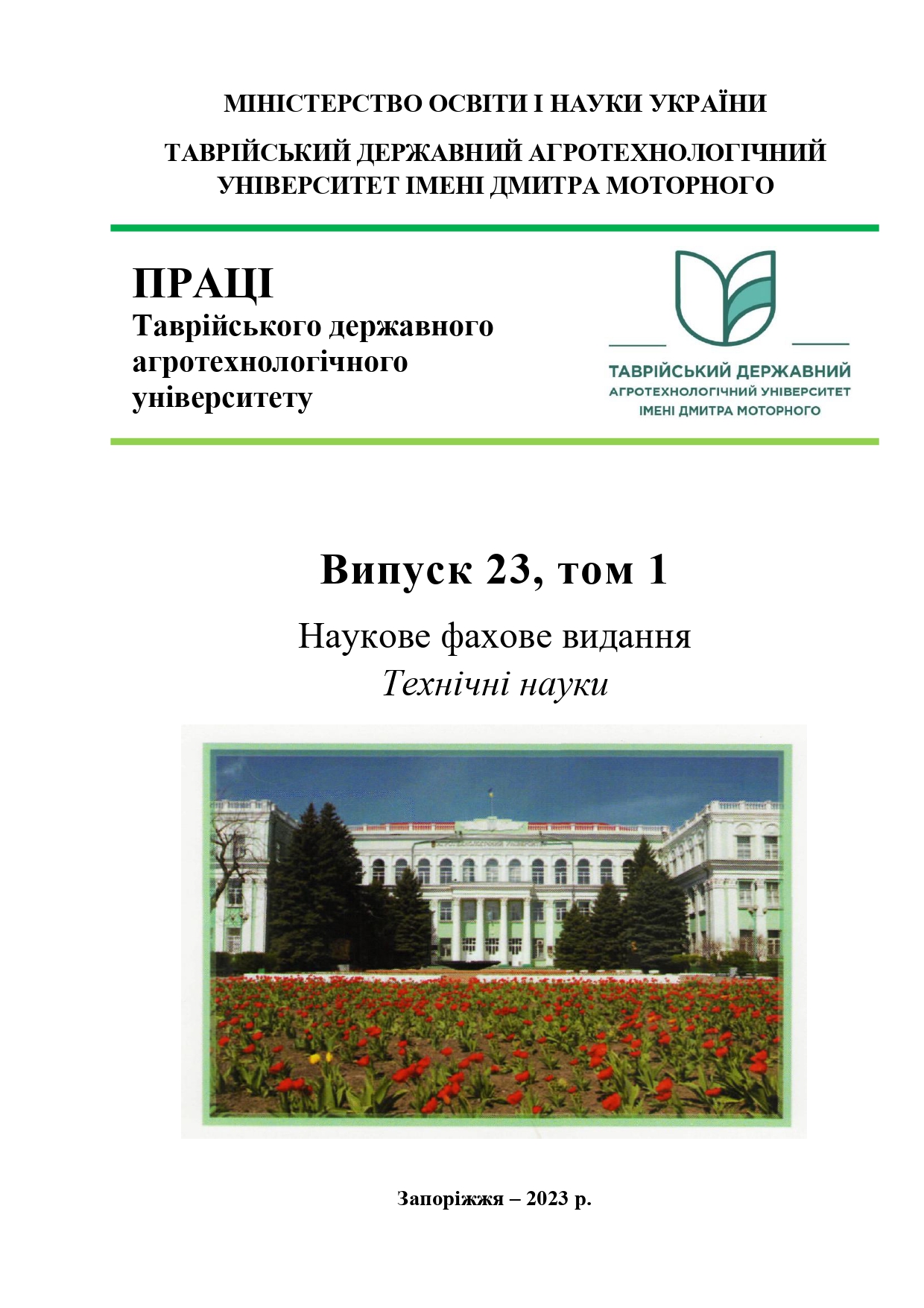ОДЕРЖАННЯ ТА ВИВЧЕННЯ ВЛАСТИВОСТЕЙ ГЕТЕРОСТРУКТУРИ ZnO/SiC/porous-Si/Si
Анотація
Анотація. У роботі наведено результати одержання гетероструктури ZnO/SiC/porous-Si/Si та вивчення її структурних та електрофізичних властивостей. Дослідження відбувалося в чотири етапи: отримання поруватих кремнієвих шарів; осадження плівок SiC методом твердофазної епітаксії; осадження плівок ZnO методом магнетронного розпилення; моделювання функціональних характеристик фотоперетворювача на основі виготовленої структури. На третьому етапі зразки були поділені на дві партії в залежності від тривалості процесу осадження (10 та 20 хвилин). За результатами скануючої електронної мікроскопії визначено параметри шарів досліджуваної структури, які в подальшому використано для моделювання фотоелектричних параметрів сонячного елемента ZnO/SiC/porous-Si/Si в симуляторі PC1D. Товщина шару ZnO визначає кількість випромінювання, що надходить до кремнієвого шару фотоперетворювача. Встановлено, що для зразків партії 2 було отримано вищий ККД – ефективність зростає із ростом плівки ZnO.
Посилання
2. Borysiewicz M. A. ZnO as a functional material, a review. Crystals. 2019. Vol. 9(10). P. 505. https://doi.org/10.3390/cryst9100505.
3. Koc N. S., Altintas S. P., Gokcen M., Dogruer M., Altug C., Varilci A. Current-voltage characteristics of nano whisker ZnO/Si heterojunction under UV exposition. Sensors and Actuators A: Physical. 2022. Vol. 342. P. 113618. https://doi.org/10.1016/j.sna.2022.113618.
4. Maqsood S., Ali Z., Ali K., Ishaq M., Sajid M., Farhan A., Rahdar A., Pandey S. Assessment of different optimized anti-reflection coatings for ZnO/Si heterojunction solar cells. Ceramics International. 2023. https://doi.org/10.1016/j.ceramint.2023.08.313.
5. Mandal L., Sadique Anwer Askari S., Kumar M., Imam M. Analysis of ZnO/Si heterojunction solar cell with interface defect. Advances in Computer, Communication and Control: Proceedings of ETES 2018. 2019. P. 533–538. https://doi.org/10.1007/978-981-13-3122-0_53.
6. Gupta C. P., Singh A. K., Jain P. K., Sharma S. K., Birla S., Sancheti S. Electrical transport properties of thermally stable n-ZnO/AlN/p-Si diode grown using RF sputtering. Materials Science in Semiconductor Processing. 2021. Vol. 128. P. 105734. https://doi.org/10.1016/ j.mssp.2021.105734.
7. Sharma A. K., Kumar R., Jha P. K., Kumar M., Chourasia N. K., Chourasia R. K. Bulk Parameters Effect and Comparative Performance Analysis of p-Si/n-CdS/ALD-ZnO Solar Cell. Silicon. 2023. Vol. 1–12. https://doi.org/10.1007/s12633-023-02518-z.
8. Kidalov V. V., Kladko V. P., Dyadenchuk A. F., Gudymenko O. I., Baturin V. A., Karpenko A. Y., Kidalov V. V. ZnO/SiC/Porous-Si/Si Heterostructure: Obtaining and Properties. Nanosistemi, Nanomateriali, Nanotehnologii. 2022. Vol. 20(3).
9. Kukushkin S. A., Osipov A. V., Romanychev A. I. Epitaxial growth of zinc oxide by the method of atomic layer deposition on SiC/Si substrates. Phys. Solid State. 2016. Vol. 58. P. 1448–1452. https://doi.org/10.1134/ S1063783416070246.
10. Kim H., Jung M. J., Choi B. J. Current transport mechanism of atomic layer deposited ZnO on 3C–SiC/p-Si heterostructure. Solid State Communications. 2021. T. 332. No 114341. https://doi.org/10.1016/j.ssc.2021. 114341.
11. Gulomov J., Accouche O., Aliev R., Ghandour R., Gulomova I. Investigation of n-ZnO/p-Si and n-TiO 2/p-Si heterojunction solar cells: TCAD+ DFT. IEEE Access. 2023. Vol. 99. P. 1–1. https://doi.org/10.1109/ACCESS.2023.3268033.
12. Ali R. S., Sharba K. S., Jabbar A. M., Chiad S. S., Abass K. H., Habubi N. F. Characterization of ZnO thin film/p-Si fabricated by vacuum evaporation method for solar cell applications. NeuroQuantology. 2020. Vol. 18(1). P. 26. https://doi.org/10.14704/nq.2020.18.1.NQ20103.
13. He J., Yang S., Wei Q. Structural and Optical Property of High Quality GaN Thin Film on Si with ZnO Buffer Layer. Journal of Photonic Materials and Technology. 2019. Vol. 5(1). P. 1–4. https://doi.org/10.11648/j. jmpt.20190501.11.
14. Li L., Sha L., Yuan Y. Photoluminescence properties of zinc oxide film with local epitaxial growth on silicon using aluminum nitride buffer layer. Acta Physica Polonica A. 2020. Vol. 137(6). P. 1110–1115. https://doi.org/10.12693/APhysPolA.137.1110.
15. Lam N. D., Van Thanh H., Thien T. D., Nguyen-Tran T. The Roles of the CuO Buffer Layer on the Photocatalytic Activity of the p-Si/p-CuO/n-ZnO Composite Films. Materials Transactions. 2023. Vol. 64(2). P. 578–585. https://doi.org/10.2320/matertrans.MT-M2022145.
16. Wahabaalla E. A., El-Menyawy E. M., Abdallah T., Youssef G. M. Improving the photoelectrical conversion efficiency of silicon solar cells using ZnO:Al/porous silicon double antireflective layers. Applied Physics A. 2019. Vol. 125(12). P. 842. https://doi.org/10.1007/s00339-019-3127-2.
17. Algün G., Akçay N. The role of etching current density and porous structure on enhanced photovoltaic performance of ZnO/PS heterojunction solar cells. Applied Physics A. 2019. Vol. 125(8). P. 568. https://doi.org/10.1007/s00339-019-2867-3.
18. Khudiar S. S., Mutlak F. A. H., Nayef U. M. Synthesis of ZnO nanostructures by hydrothermal method deposited on porous silicon for photo-conversion application. Optik. 2021. Vol. 247. No 167903. https://doi.org/10.1016/j.ijleo.2021.167903.
19. Hotza D., Di Luccio M., Wilhelm M., Iwamoto Y., Bernard S., da Costa J.C.D. Silicon carbide filters and porous membranes: A review of processing, properties, performance and application. Journal of Membrane Science. 2020. Vol. 610. No 118193. https://doi.org/10.1016/j.memsci.2020.118193.
20. Zhang Y., Lin N., Li Y., Wang X., Wang H., Kang J., Wilks R., Bär M., Mu R. The isotype ZnO/SiC heterojunction prepared by molecular beam epitaxy – A chemical inert interface with significant band discontinuities. Sci Rep. 2016. Vol. 6. No 23106. https://doi.org/10.1038/srep23106.
21. Duan L., Lin B., Yao R., Fu Z. The properties of ZnO/SiC/Si heterostructure. Chinese Journal of Materials Research. 2006. Vol. 20(3). P. 259.
22. Chung Gwiy-Sang. Characteristics of ZnO Films Deposited on Poly 3C-SiC Buffer Layer by Sol-Gel Method. Transactions on Electrical and Electronic Materials. 2011. Vol. 12(3). P. 102–105. https://doi.org/10.4313/ TEEM.2011.12.3.102.
23. Duy-Thach Phan, Gwiy-Sang Chung. Comparison of ZnO thin films grown on a polycrystalline 3C–SiC buffer layer by RF magnetron sputtering and a sol–gel method. Applied Surface Science. 2011. Vol. 257(8). P. 3285–3290. https://doi.org/10.1016/j.apsusc.2010.11.003.
24. Kim H., Jung M. J., Choi S., Choi B. J. Atomic layer deposition of ZnO for modulation of electrical properties in n-GaN Schottky contacts. Journal of Electronic Materials. 2021. Vol. 50. P. 1955–1962. https://doi.org/10.1007/s11664-020-08673-y.
25. Kobayashi H., Tachibana S., Yamanaka K., Nakato Y., Yoneda K. Improvement ofindium-tin-oxide/silicon oxide/n-Si junction solar cell characteristics by cyanide treatment. J Appl Phys. 1997. Vol. 81(11). P. 7630–7634. https://doi.org/10.1063/1.365340.
26. Xiaopeng Wu, Xiaoqing Chen, Lijie Sun, Shun Mao, Zhuxi Fu. Photoelectric conversion characteristics of ZnO/SiC/Si heterojunctions. Journal of Semiconductors. 2010. Vol. 31. No 103002. https://doi.org/10.1088/ 1674-4926/31/10/103002.
27. Sasmal Sajal, Ray Mrityunjoy. Optimization of multijunction solar cell by wafer ray tracer for development of high photogenerated. International Journal of Research in Engineering and Technology. 2015. 04. https://doi.org/10.15623/ijret.2015.0404065.
28. Kidalov V. V., Dyadenchuk A. F., Khrypko S. L., Khrypko O. S. Investigation the Structures ZnO:Al/SiOx/PorSi/p-Si/Al. Physics and Chemistry of Solid State. 2017. Vol. 18(2). P. 180-183. https://doi.org/10.15330/ pcss.18.2.180-183.
29. Kidalov V. V., Kukushkin S. A., Osipov A. V., Redkov A. V., Grashchenko A. S., Soshnikov I. P., Boiko M. E., Sharkov M. D., Dyadenchuk A. F. Properties of SiC films obtained by the method of substitution of atoms on porous silicon. ECS Journal of Solid State Science and Technology. 2018. Vol. 7(4). P. 158. https://doi.org/10.1149/2.0061804jss.
30. Кідалов В. В., Кукушкін С. А., Осіпов А. В., Редьков А. В., Гращенко А. С., Сошніков І. П., Бойко М. Е., Шарков М. Д., Дяденчук А. Ф. Гетероепітаксійний ріст SiC на підкладках поруватого Si методом заміщення атомів. Журнал нано- та електронної фізики. 2018. Т. 10, № 3. С. 03026 (6cc). https://doi.org/10.21272/jnep.10(3). 03026.
31. Amoozadeh A., Rahmani S. Nano-WO3-supported sulfonic acid: New, efficient and high reusable heterogeneous nano catalyst. J. Mol. Catal. A: Chem. 2015. T. 396. P. 96–107. https://doi.org/10.1016/j.molcata. 2014.09.020.
32. Gran J., Kübarsepp T., Sildoja M., Manoocheri F., Ikonen E., Müller I. Simulations of a predictable quantum efficient detector with PC1D. Metrologia. 2012. Vol. 49(2). P. 130. https://doi.org/10.1088/0026-1394/49/2/S130.
33. Thirunavukkarasu G. S., Seyedmahmoudian M., Chandran J., Stojcevski A., Subramanian M., Marnadu R., Alfaify S., Shkir M. Optimization of mono-crystalline silicon solar cell devices using PC1D simulation. Energies. 2021. Vol. 14(16). No 4986. https://doi.org/10.3390/en 14164986.
34. Hashmi G., Rashid M. J., Mahmood Z. H., Hoq M., Rahman M. H. Investigation of the impact of different ARC layers using PC1D simulation: application to crystalline silicon solar cells. Journal of Theoretical and Applied Physics. 2018. Vol. 12. P. 327–334. https://doi.org/10.1007/s40094-018-0313-0.
35. Shah D. K., KC D., Akhtar M. S., Kim C. Y., Yang O. B. Vertically arranged zinc oxide nanorods as antireflection layer for crystalline silicon solar cell: a simulation study of photovoltaic properties. Applied Sciences. 2020. Vol. 10(17). P. 6062. https://doi.org/10.3390/app 10176062.
36. Shah D. K., Devendra K. C., Kim T. G., Akhtar M. S., Kim C. Y., Yang O. B. Influence of minority charge carrier lifetime and concentration on crystalline silicon solar cells based on double antireflection coating: A simulation study. Optical Materials. 2021. Vol. 121. No 111500. https://doi.org/10.1016/j.optmat.2021.111500.
37. Laohawiroj S., Fangsuwannarak T., Rattanawichai P., Limsiri W., Naidoo N.J., Phatthanakun R. Silicon composite films as an anti-reflection coating layer for third generation photovoltaic. Suranaree Journal of Science & Technology. 2022. Vol. 29(3).
38. Dyadenchuk A., Domina N., Oleksenko R. Simulation of Solar Element Characteristics Based on Porous Silicon. 2022 IEEE 4th International Conference on Modern Electrical and Energy System (MEES). 2022. P. 1–4. https://doi.org/10.1109/MEES58014.2022.10005773.
39. Дяденчук А. Ф., Філіпович Є. В. Моделювання функціональних характеристик сонячних елементів на основі ZnO і TiO2. Науковий вісник ТДАТУ. 2022. Вип. 12, т. 1. С. 1–11. https://doi.org/10.31388/sbtsatu.v12i1.299.



